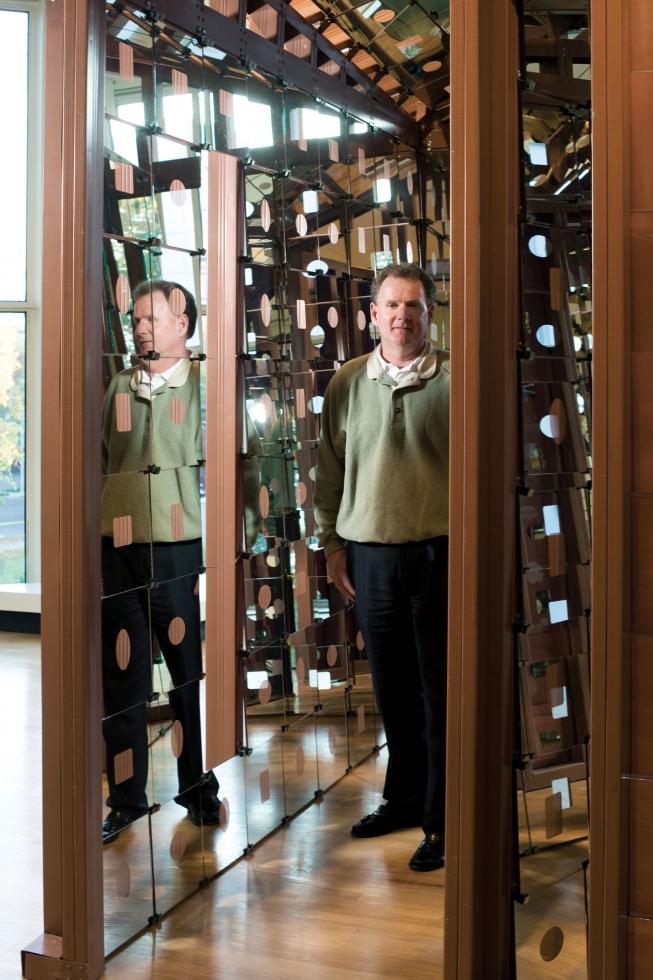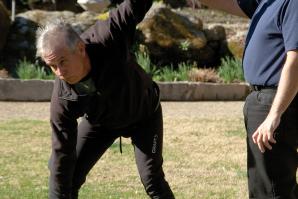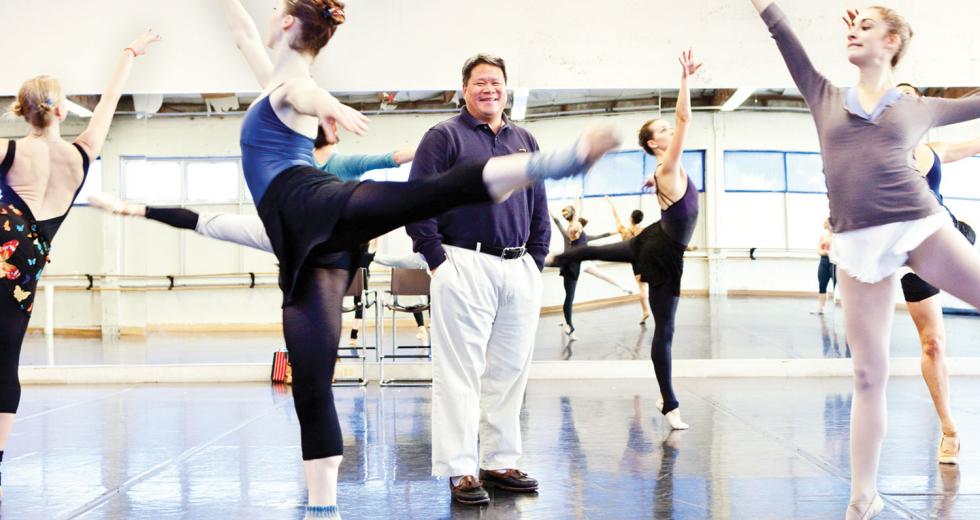Michael Genovese, partner with Genovese Burford & Brothers, has
served on the Crocker’s board for a decade.
(Photo courtesy of Mike Graffigna)

Amid the country’s worst economy in decades, Michael Genovese was offered more work, and he refused.
The Crocker Art Museum was looking for a new investment advisory firm. In any other situation, Genovese would have been a perfect solution. Not only is he a partner at Sacramento investment firm Genovese Burford & Brothers, but he’s also served on the Crocker’s board for 10 years. The conflict of interest prohibited double duty, but when management asked Genovese if he wanted to quit the board so the museum could use his firm, he declined.
He said he could better serve the museum by keeping his position as head of the board that manages endowment money, the funds primarily used to make investments and support programs. To him, the opportunity to provide free time and knowledge is worth more than making a buck off the museum.
“That’s something you have to decide before you even take a position on a board,” he says. “You have to ask yourself, ‘Am I trying to build a resume in a business context, or am I trying to perform the appropriate function?’ I think a lot of people are on boards for the wrong reasons. But I’m not here to get business. I’m here to do what I can for the museum.”
Every pocket of America has felt the recession. Nonprofits and arts organizations have been especially hammered as the economy has caused charitable donations to disappear and revenue streams to dry up.
“We have seen numerous instances of arts organizations in trouble or actually folding during these economic times throughout the state,” says Mary Beth Barber, communications director for the California Arts Council.
But as budgets have gone down, nonprofit board members such as Genovese have stepped up and lent more support than ever. It’s no easy role. In fact, some board members have resigned, unable to face a road that requires more responsibility and longer volunteer hours. Those who have stayed committed have become key components to the survival of these organizations: Nonprofits rely heavily on their marketing and financial expertise to find creative ways to stretch dollars and raise funds.
Curtis Dair fits that bill. He’s the senior vice president for lending at The Golden 1, and for the past five years, he’s served on the board of the Sacramento Ballet. Last year, when the economy tumbled, nine of the 21 board members stepped down. Dair stayed.
Normally, board members help organize events, solicit sponsorships and give marketing advice. But now, with fewer members, the board has to contribute in new ways: bartering with city businesses, delving deeply into weekly cash flow projections and business plans, and helping with creative fundraising activities and other marketing events.
“I think when you’re in fundraising mode, you forget that you need an operating budget.”
Michael Genovese, partner, Genovese Burford & Brothers
For instance, when Tiffany & Co. opened at the Roseville Galleria, the board helped bring dancers to the grand opening to increase awareness of the company.
Despite efforts to be more visible in the community and organize new fundraisers, financial challenges remain. The company must raise private and corporate funds, provide dancers with a decent wage and make sure performances maintain their quality. To compensate for losses and keep ticket prices affordable, efforts were made to cut staff, restructure credit lines, reduce the marketing budget and slash expenses.
But the biggest financial decision came last spring when the company canceled performances to avoid paying rent to the Community Center Theater. Ticketholders were offered refunds or passes to other arts performances in the city. The ballet dancers did not disappear completely, and in fact became very involved in fundraising. But instead of using the theater, dancers put together smaller shows at different venues, including their rehearsal studio downtown.
The studio, however, is not cut out for the type of grand productions the company hosts at the theater. It has no elaborate lighting setup, no backstage. An old wooden piano is parked in a corner, and a hanging air-conditioning unit whirs. The community theater usually holds about 2,000 people and has a refreshment bar. The studio maxes out around 100 with people packed in two rows along the walls. No need for ushers.
From January to May, the company held 45 in-studio performances compared to the typical average of 10 in-studio shows. Ticket prices ranged from $10 to $35.
“We had a smaller audience. It was more informal, and dancers were up closer,” Dair says. “But we were already paying rent there. That move helped us survive the first half of the year.”
Other performance organizations in the region have also felt the sting of declining ticket sales and decreases in charitable donations. When the recession hit the Sacramento Theatre Co., management worked with board members to review insurance policies, reduce staff and cut costs without impacting the product, says Damaris Perez, a theater board member and vice president of tax services for Perry-Smith LLP.
“It’s been a hard time,” she says. “Nonprofits have been severely impacted because everyone’s cutting back. The easiest thing to do for everybody has been to cut back on charitable contributions.”
Fortunately, she added, a generous family donated a residence to the organization, which will be raffled in 2010. But even with that gift, board members and management are strategizing to keep the budget realistic. With her accounting background, Perez brings valuable left-brain insight to a typically right-brained world.
“When you look at management, it is mostly comprised of artistically oriented folks,” she says. “Finances don’t come as naturally as they would to someone like myself. On the other side, I’m not an artistic person, so it comes back to the management team. It’s a collaborative effort.”
At the B Street Theatre, the board has taken a more active role in monitoring expenses, says Thomas Knox, president of the board of directors and a partner with Knox Lemmon Anapolsky & Schrimp LLP. The finance committee meets every month with management, and they have had to make difficult choices. For example, last year B Street considered presenting Arthur Miller’s “A View from the Bridge,” but the production had so many characters that they decided against it. In addition, Knox says, the board has been developing ideas for fall fundraisers, cutting costs on items such as announcement mailings, and asking members to solicit funds directly from Rotary clubs and 20-30 clubs.
“When times get tough, many people start cutting back on charitable contributions and money they spend on entertainment,” Knox says. “B Street has been adversely affected as a result.”
“We have seen numerous instances of arts organizations in trouble or actually folding during these economic times throughout the state.”
Mary Beth Barber, communications director, California Arts Council
In many cases, board members have contributed to the organization by increasing personal donations. At the Association of California Symphony Orchestras, these donations are called “sacrificial gifts,” or the largest amount a board member can afford to give.
“They try to close the gap if there’s a projected deficit in the budget,” says Kris Sinclair, executive director of ACSO, which is based in Sacramento and has 120 members statewide.
Sinclair cites an example of the San Luis Obispo Symphony board of directors, which recently made a collective decision to increase personal gifts by 15 to 20 percent.
Such efforts and dedication pay off in the long run. For example, because of the support from the community and the commitment of the staff and board members, the Sacramento Ballet finished last season with a net profit, Dair says. The company has also seen an 86 percent subscription renewal for the 2009-2010 season, which, he added, is “stronger than usual.”
“We are back at full strength,” Dair says, “producing an exciting season of compelling dance.”
To navigate tough times at the Crocker Art Museum, Genovese has worked with board members and the management team to solicit donors and make the investment policy statement more conservative. In some cases, board members have also written bigger checks themselves.
Board members, he says, have been very careful not to cannibalize the museum’s donor base. Meaning, they could have gone out and requested $100,000 in exchange for a donor’s name on the wall. But that single large donation might have canceled out a donor’s annual $5,000 donation. When that happens, “the current operating budget starts looking ugly,” Genovese says.
“It becomes harder to pay SMUD and benefits and salaries,” he says. “I think when you’re in fundraising mode, you forget that you need an operating budget.”
In his 10 years at the Crocker, Genovese has filled numerous roles, from board president to chair of the investment committee. But he has never had to deal with this degree of financial difficulty before.
“The past couple of years have been a train wreck for any nonprofit,” Genovese says. “People are obviously pulling in the reins a little bit, even though now is the time when organizations desperately need money to keep doors open and keep the boat afloat.”
The Crocker is undergoing an expansion that will triple the size of the museum with a 100,000-square-foot wing. The new building will include a 300-seat auditorium, more parking spaces and three times the space for the permanent collection. Raising money to complete the project has been a huge challenge, but Genovese says the museum refuses to quit.
“There’s no turning back,” he says.
Recommended For You

C-Suite Workouts
When exercise is part of your executive strategy
When Jim and Diane Williams were forced to admit their age, they also had to admit that many things they took for granted in their younger years now needed a little more attention and discipline.

Be a Better Board Member
Strategic ways to improve your nonprofit service and personal gain
Board members are introduced and then immediately expected to get along, share ideas and be productive. But that’s a difficult pattern for boards to follow effectively. So what makes a stellar board member?



